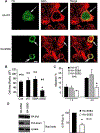Tiam1 is recruited to β1-integrin complexes by 14-3-3ζ where it mediates integrin-induced Rac1 activation and motility
- PMID: 21302295
- PMCID: PMC6385608
- DOI: 10.1002/jcp.22644
Tiam1 is recruited to β1-integrin complexes by 14-3-3ζ where it mediates integrin-induced Rac1 activation and motility
Abstract
14-3-3 is an adaptor protein that localizes to the leading edge of spreading cells, returning to the cytoplasm as spreading ceases. Previously, we showed that integrin-induced Rac1 activation and spreading were inhibited by sequestration of 14-3-3ζ and restored by its overexpression. Here, we determined whether 14-3-3 mediates integrin signaling by localizing a guanine nucleotide exchange factor (GEF) to Rac1-activating integrin complexes. We showed that GST-14-3-3ζ recruited the Rac1-GEF, Tiam1, from cell lysates through Tiam1 residues 1-182 (N(1-182) Tiam1). The physiological relevance of this interaction was examined in serum-starved Hela cells plated on fibronectin. Both Tiam1 and N(1-182) Tiam1 were recruited to 14-3-3-containing β1-integrin complexes, as shown by co-localization and co-immunoprecipitation. Integrin-induced Rac1 activation was inhibited when Tiam1 was depleted with siRNA or by overexpression of catalytically inactive N(1-182) Tiam1, which was incorporated into 14-3-3/β1-integrin complexes and inhibited spreading in a manner that was overcome by constitutively active Rac1. Integrin-induced Rac1 activation, spreading, and migration were also inhibited by overexpression of 14-3-3ζ S58D, which was unable to recruit Tiam1 from lysates, co-immunoprecipitate with Tiam1, or mediate its incorporation into β1-integrin complexes. Taken together, these findings suggest a previously unrecognized mechanism of integrin-induced Rac1 activation in which 14-3-3 dimers localize Tiam1 to integrin complexes, where it mediates integrin-dependent Rac1 activation, thus initiating motility-inducing pathways. Moreover, since Tiam1 is recruited to other sites of localized Rac1 activation through its PH-CC-EX domain, the present findings show that a mechanism involving its N-terminal 182 residues is utilized to recruit Tiam1 to motility-inducing integrin complexes.
Copyright © 2011 Wiley-Liss, Inc.
Figures








References
-
- Aitken A 2006. 14–3-3 proteins: A historic overview. Semin Cancer Biol 16:162–172. - PubMed
-
- Aitken A, Baxter H, Dubois T, Clokie S, Mackie S, Mitchell K, Peden A, Zemlickova E. 2002. Specificity of14–3-3 isoform dimer interactions and phosphorylation. Biochem Soc Trans 30:351–360. - PubMed
-
- Albiges-Rizo C, Frachet P, Block MR. 1995. Down regulation of talin alters cell adhesion and the processing of the α5β1 integrin. J Cell Sci 108:3317–3329. - PubMed
-
- Angrand PO, Segura I, Volkel P, Ghidelli S, Terry R, Brajenovic M, Vintersten K, Klein R, Superti-Furga G, Drewes G, Kuster B, Bouwmeester T, Acker-Palmer A. 2006. Transgenic mouse proteomics identifies new 14–3-3-associated proteins involved in cytoskeletal rearrangements and cell signaling. Mol Cell Proteomics 5:2211–2227. - PubMed
Publication types
MeSH terms
Substances
Grants and funding
LinkOut - more resources
Full Text Sources
Other Literature Sources
Research Materials

